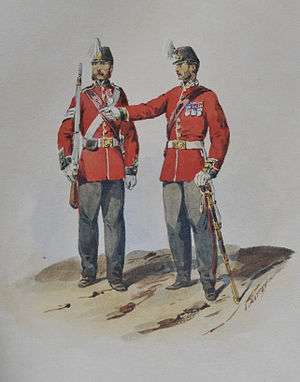101st Regiment of Foot (Royal Bengal Fusiliers)
| 101st Regiment of Foot | |
|---|---|
| Active | 1652–1881 |
| Country | British Empire |
| Branch | Army |
| Type | Infantry |
| Battle honours | See Battle Honours section |
The 101st Regiment of Foot (Royal Bengal Fusiliers) was a regiment of the British Army from 1862 to 1881. They possessed a previous history in the Bengal Army dating back to 1652.
History

The regiment was formed as part of the Honourable East India Company's army firstly as a Guard of Honour in 1652. By 1756 it was renamed the Bengal European Regiment - 'European' indicating it was composed of white soldiers, not Indian sepoys. When this regiment was split into three regiments in 1765, one part became the 1st Bengal European Regiment.
In 1846 the regiment became the 1st Bengal European Fusiliers, also referred to in contemporary official papers, with inverted word ordering, as 1st European Bengal Fusiliers.[1] It retained this title until British India was transferred to British rule after the Indian Mutiny of 1857. The "European" was then dropped and replaced by Royal. Thus, the title in 1861 became the 1st Royal Bengal Fusiliers. The regiment was then transferred to the British Army and renumbered as the 101st Regiment of Foot at the same time retaining the Royal Bengal name. In 1881 it was combined with the 104th Regiment of Foot (Bengal Fusiliers) to form part of the new Royal Munster Fusiliers.
Indian Mutiny

On the outbreak of the Indian Mutiny the order to march on Delhi was given from Simla, and reached the regiment at Dugshai via Major George Ogle Jacob on 13 May 1857. After receiving the order, the regiment marched down from its rest station at Dugshai, due to reach Umballa that evening.[2]
Major George Ogle Jacob was mortally wounded at Delhi on 14 September 1857 aged 38, having been wounded in the morning and died in camp at 10 pm. He was the son of Surgeon George Jacob (Bengal Medical Service) and had joined the Bengal Army in 1837, serving in Afghanistan (1838) and Sutlej (1845).[3] His grave at Rajpura Cemetery, Delhi states: "Sacred to the memory of Major George Ogle Jacob, 1st Bengal Fusiliers, who whilst commanding his Regiment fell mortally wounded at the storming of Delhi, on the 14th September 1857, aged 38 years. This monument is erected by his family."
Battle Honours
Battle honours awarded to the Regiment were:[4]
Victoria Crosses
- Lieutenant Francis Brown, Indian Mutiny (16 November 1857)
- Lieutenant Thomas Adair Butler, Indian Mutiny (9 March 1858)
- Private John McGovern, Indian Mutiny (23 June 1857)
- Sergeant James McGuire, Indian Mutiny (14 September 1857)
- Drummer Miles Ryan, Indian Mutiny (14 September 1857)
Colonels of the Regiment
Colonels of the Regiment included:[4]
- 101st Regiment of Foot (Royal Bengal Fusiliers)
- 1862–1873: Lt-Gen. Sir Abraham Roberts, GCB
- 1873–1881: Gen. Corbet Cotton
References
- ↑ For example in the correspondence of Lt.Col. George Gladwin Denniss(1821-1862) (ed. P. Chantler, South Molton, 2010) who invariably placed the word "European" before "Bengal"
- ↑ Correspondence of Lt.Col. George Gladwin Denniss II, 13/5/1857, ed. P. Chantler, South Molton, 2010
- ↑ (list of memorials from Indian Mutiny). His mother was Mrs M.A. Jacobs, who was paid a pension by the HEICS (from a list in Bombay Times, 11 Aug.1858)
- 1 2 "101st Regiment of Foot (Royal Bengal Fusiliers)". regiments.org. Archived from the original on 30 March 2006. Retrieved 17 August 2016.
External links
- "101st Regiment of Foot (Royal Bengal Fusiliers)". regiments.org. Archived from the original on 13 January 2008.